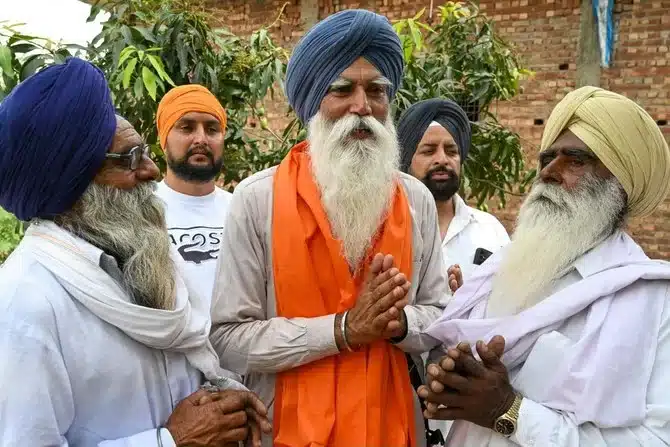Once hailed as the invincible force shaping India’s political landscape, ‘Brand Modi’ now stands at a crossroads. The 2024 elections brought an unforeseen plot twist, leaving pundits and citizens alike pondering: Is the magic of ‘Brand Modi’ fading?
The 2024 Lok Sabha elections didn’t just mark a change in political power; they symbolized a profound shift in Indian society’s values and priorities.
The decisive turn away from the Hindutva narrative and divisive tactics of the Bharatiya Janata Party (BJP) sends a clear message: the electorate demands more than rhetoric and polarization. This seismic shift isn’t just a wake-up call for the BJP; it’s a call to action for all political parties. In a diverse and complex democracy like India, inclusivity and effective governance are not just buzzwords; they’re prerequisites for progress.
![N. Chandrababu Naidu and Nitish Kumar emerge as kingmakers in this election [Image via NDTV].](https://southasiatimes.org/wp-content/uploads/2024/06/ro2u1ta_modi-nitish-naidu_625x300_06_June_24-1.webp)
Also See: A Decade of Modi: India’s Democratic and Diplomatic Conundrum
Brand Modi Upset: Key Highlights
- Unmet Expectations: Despite extensive media and social media campaigns, the BJP-led NDA fell short of projections. Prime Minister Narendra Modi, once a formidable force in Indian politics, faced a personal and political setback as the party’s performance failed to meet anticipated outcomes.
- Tarnished Reputation Abroad: The BJP’s mishandling of its Sikh diaspora in Canada and involvement in a controversial incident involving rogue RAW elements on US soil significantly tarnished its reputation in Western media. Modi’s policies, perceived as misaligned with Western democratic principles, failed to garner positive attention, contributing to the BJP’s underperformance in the elections.
- Rejected Rhetoric: Modi’s aggressive rhetoric against Pakistan and reliance on divisive Hindutva policies did not resonate with voters. The electorate prioritized pressing issues like unemployment, inflation, and social inequality over nationalist and anti-Muslim sentiments. This rejection of fear-mongering and divisive strategies signaled a demand for more substantive solutions to the nation’s challenges.
- Congress Resurgence: The Congress-led opposition alliance defied earlier forecasts of decline, making significant gains. The BJP’s loss of seats, particularly in key states like Uttar Pradesh, indicated a shifting political landscape and a weakening of Modi’s influence.
- Rise of Wealth in Politics: The elections revealed a significant shift within the BJP, with a notable increase in affluent politicians. Data from the Association for Democratic Reforms (ADR) showed that 504 out of 543 winning candidates were crorepatis, highlighting the growing influence of wealth in Indian politics. Notable affluent victors included Dr. Chandra Sekhar Pemmasani, Konda Vishweshwar Reddy, and Naveen Jindal.
- Erosion of “Brand Modi”: Despite adept branding and media management, Modi’s once-unassailable image suffered a significant blow, opening avenues for the opposition to challenge his dominance.
- Return to Coalition Politics: The election results pointed towards a return to coalition politics, reminiscent of India’s history of diverse coalition governments. To form a government, the BJP would need a more collaborative approach, heavily reliant on allies whose support could prove fragile if neglected.
- Need for Peaceful Relations and Inclusivity: The BJP must recognize the importance of fostering peaceful relations with its smaller neighbors, refraining from interfering in their domestic politics, and ensuring fair treatment of religious minorities within India. Abandoning politics characterized by arrogance, divisiveness, and communalism is imperative to avoid further erosion of political support.
![Congress describes Lok Sabha poll results as a 'political and moral defeat of Narendra Modi' [Image via INC]](https://southasiatimes.org/wp-content/uploads/2024/06/20240604_205805-860x573-1.webp)
Symbolic Defeat in Faizabad
Nothing could have been more symbolic than the outcome in Faizabad on June 4, the day election results showed the BJP losing its majority. Despite the high-profile consecration of the Ram Temple in January 2024, the BJP lost the Faizabad parliamentary seat, which includes Ayodhya, revealing that the much-hyped temple inauguration failed to impress voters, including a majority of Hindus in the region.
Election Results
The BJP’s tally stood at 240 seats, falling short of the 272 majority mark. While the National Democratic Alliance (NDA) secured an additional 44 seats, the slim majority starkly contrasted previous elections where the BJP secured 282 seats in 2014 and 303 in 2019.
Opposition Gains
The Congress won 99 seats, a significant improvement from its 2014 tally of 44 and 2019 tally of 52. The opposition platform, the Indian National Developmental Inclusive Alliance (INDIA bloc), notched up a tally of about 230 seats, challenging the BJP’s dominance.
Decoding the Fall of Brand Modi
The 2024 verdict is seen as a corrective measure, rejecting Modi’s centralized and authoritarian style of governance. The BJP’s losses in traditional strongholds like Uttar Pradesh and Maharashtra, coupled with the rise of affluent candidates, reflect a disconnect with the electorate’s priorities.
The failure of the BJP’s Hindutva narrative, particularly in regions like Faizabad and Banswara, where anti-Muslim rhetoric and divisive tactics did not yield expected results, marks a significant shift in voter sentiment. The electorate’s rejection of Modi’s personality cult and call for more collaborative and ethical politics underscore a demand for governance that addresses real issues over divisive ideologies.
Inward vs. Outward Strategy
Modi’s strategy of balancing an inward focus on Hindu nationalist policies with an outward emphasis on India’s global image failed to deliver the expected results. Domestically, voters rejected the polarizing Hindutva narrative and sought solutions to pressing issues like unemployment and inflation. Internationally, Modi’s failure to align with Western democratic values and mishandling of diaspora issues damaged his global standing.

A Failure for “Brand Modi”
This election is a clear indictment of “Brand Modi.” Despite extensive branding and media management, Modi’s once-unassailable image suffered significant damage. The results indicate a growing disillusionment with his leadership style and divisive rhetoric. Modi’s inability to translate his international appeal into domestic success highlights a critical disconnect between his outward ambitions and the inward needs of the Indian electorate.
As the BJP faces the challenge of running a government with a slim majority, the need for a more inclusive and less divisive approach becomes evident. The electorate’s priorities have shifted towards tangible issues like employment and social equity, signaling a demand for substantive governance over polarizing politics. The 2024 elections mark a critical juncture for the BJP, necessitating a strategic overhaul to remain relevant in a rapidly evolving political landscape.
The views expressed in this article are the author’s own. They do not necessarily reflect the editorial policy of the South Asia Times.
Haleema Khalid is an Editor and Research Lead at South Asia Times. She holds a Master's degree in Applied Linguistics and a Bachelor's in Social Work. Her research interests include exploring language's impact on society and culture.


![Congress describes Lok Sabha poll results as a 'political and moral defeat of Narendra Modi' [Image via INC]](context.core.image.imageCurrentSrc)
![Congress describes Lok Sabha poll results as a 'political and moral defeat of Narendra Modi' [Image via INC]](selectors.core.image.enlargedImgSrc)

![Muslim female students wearing hijabs are denied entry to classrooms in Udupi, reflecting rights violations in India's Karnataka [Image Credits: AP]](https://southasiatimes.org/wp-content/uploads/2022/02/202202asia_india_udupi_hijab-150x150.webp)


Add a Comment